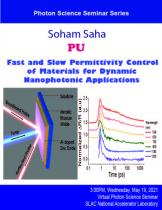Speaker: Soham Saha, Purdue University
Program Description:
The dielectric permittivity or the refractive index of a material encapsulates the essential physics of light-matter interactions with the material. Thus, controlling the material permittivity enables control over the amplitude, phase, and polarization of light interacting with them.
How do we control permittivity? Here, I will highlight two techniques to control the optical responses of conducting oxides and nitrides. First, we tailor the epsilon-near-zero points of cadmium oxide from 11 µm to 5 µm by doping, to develop fast all-optical switches. Secondly, utilizing undoped zinc oxide, we show real-time control over the permittivity by interband pumping, achieving picosecond-speed reflectance modulation in the telecom regime.
Can we control the speed of an all-optical switch? I will share our results where, by employing titanium nitride with a nanosecond response, and aluminum-doped zinc oxide with a picosecond response, we tune the switching speed of a metasurface from the nanosecond to the picosecond scale.
Finally, employing the robust, refractory materials we meticulously characterized, I will highlight the new physics we are currently studying, covering time-reflection and high-harmonic generation. A comprehensive understanding of permittivity-control and the temporal response of materials will enable us to design practical tunable devices spanning the telecom to the mid-infrared regime.
References:
- Saha, S.; Dutta, A.; DeVault, C.; Diroll, B. T.; Schaller, R. D.; Kudyshev, Z.; Xu, X.; Kildishev, A.; Shalaev, V. M.; Boltasseva, A. Extraordinarily Large Permittivity Modulation in Zinc Oxide for Dynamic Nanophotonics. Materials Today, accepted 2020.
- Saha, S.; Diroll, B. T.; Shank, J.; Kudyshev, Z.; Dutta, A.; Chowdhury, S. N.; Luk, T. S.; Campione, S.; Schaller, R. D.; Shalaev, V. M.; Boltasseva, A.; Wood, M. G. Broadband, High‐Speed, and Large‐Amplitude Dynamic Optical Switching with Yttrium‐Doped Cadmium Oxide. Adv. Funct. Mater. 2020, 30 (7), 1908377. https://doi.org/10.1002/adfm.201908377.
- Saha, S.; Diroll, B.; Dutta, A.; DeVault, C.; Kildishev, A. V.; Wood, M.; Shalaev, V. M.; Schaller, R.; Boltasseva, A. Lithography-Free All-Optical Switching from the Telecom to the Mid-Infrared Regime with Transparent Conducting Oxides. In SPIE Optics+Photonics, Active Photonic Platforms XII; Subramania, G. S., Foteinopoulou, S., Eds.; SPIE, 2020; Vol. 11461, p 60. https://doi.org/10.1117/12.2567774.
- Korobenko, A.; Saha, S.; Godfrey, A. T. K. ; Gertsvolf, M. ; Naumov, A. Y.; Villeneuve, D. M.; Boltasseva, A.; Shalaev, V. M.; Corkum, P. B. High-harmonic generation in metallic titanium nitride arXiv 2020.
Speaker Biography: Soham Saha is a Ph.D. graduate of the School of Electrical and Computer Engineering at Purdue University, co-supervised by Prof. Vladimir Shalaev and Prof. Alexandra Boltasseva. His research focuses on the development of optical materials for active nanophotonics, nonlinear optics, and all-optical switching. He is a recipient of the Meissner Fellowship, the Society of Vacuum Coaters Scholarship, the SPIE Education Scholarship, and the Purdue ECE Outstanding Graduate Research Award. In 2020, he participated in the Interdisciplinary Lindau Nobel Meetings. Saha can be reached by email at .





